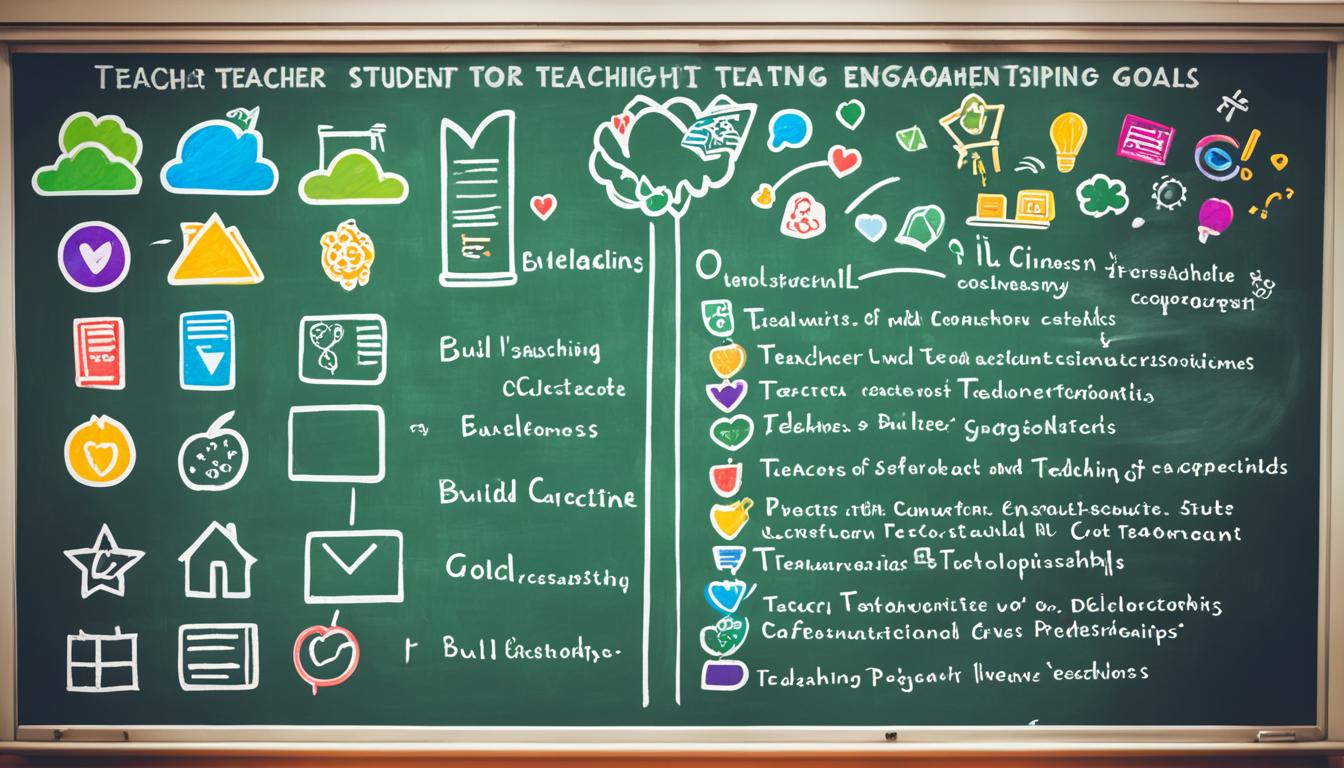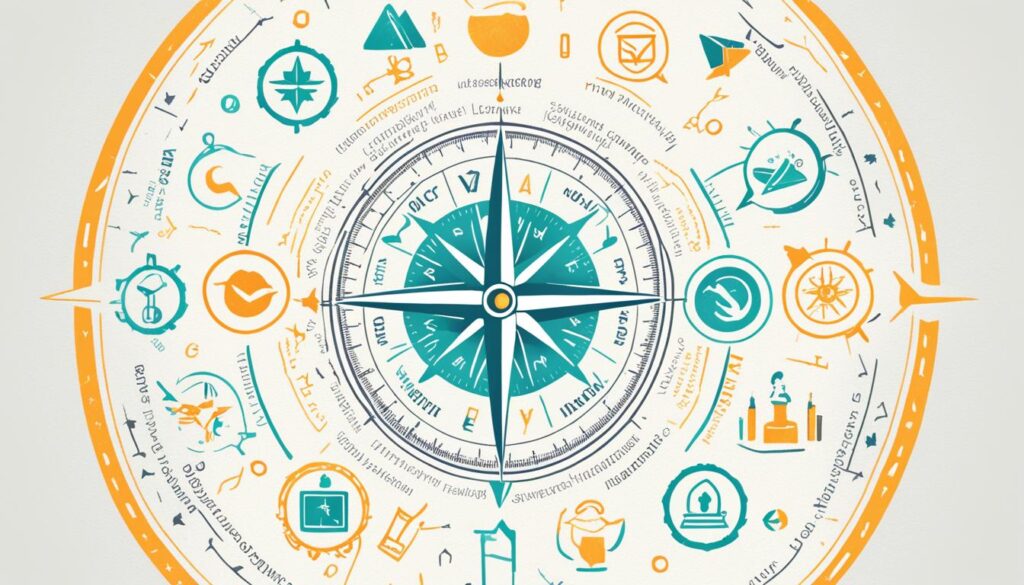Achieve Success: Teacher Professional Goals Examples

Are you ready to take your teaching career to the next level? Do you want to make a lasting impact on your students and create a fulfilling professional journey? Setting professional goals is the key to unlock your true potential as an educator. But what are the examples of teacher professional goals that can help you thrive in your field? Let’s explore some inspiring examples and discover the path to achieving your career objectives as a teacher.
Key Takeaways:
- Setting professional goals is important for teachers to enhance their skills and career growth.
- Examples of teacher professional goals can include skill development, leadership responsibilities, and expanding networks.
- Professional goals provide direction, motivation, and help teachers stay up-to-date in their field.
- SMART goal-setting is a powerful framework for setting clear and achievable objectives.
- By continuously reflecting, adapting, and seeking support, teachers can achieve their professional goals and make a lasting impact on student learning.
Why Professional Goals are Essential for Teachers
Professional goals are crucial for educators as they provide clarity, motivation, and growth opportunities. By setting specific and measurable goals, teachers can enhance their skills, increase student engagement, improve communication with parents, maintain an organized classroom, facilitate student learning, and track student progress.
Setting professional development goals also aligns with teaching career aspirations. It helps teachers achieve academic success, develop leadership skills, and enhance work-life balance. By setting goals that are relevant to their values and ambitions, teachers can make informed decisions, overcome challenges, and continuously improve in their roles. As a result, achieving professional goals not only benefits teachers but also has a positive impact on student learning and overall classroom effectiveness.

When educators set professional goals, they create a roadmap for their own growth and development. These goals provide teachers with a sense of purpose and direction, allowing them to focus their efforts on areas that matter most to their teaching practice.
Furthermore, professional goals help teachers stay motivated and inspired. They serve as a reminder of the impact educators can have on their students’ lives and encourage teachers to strive for excellence in their teaching.
In addition, setting performance targets enables teachers to reflect on their teaching practices regularly. It allows them to identify areas for improvement and implement strategies that enhance their instruction and engagement with students.
By setting professional goals, teachers create opportunities for their own professional advancement. Whether it’s pursuing advanced degrees, attending conferences and workshops, or taking on leadership roles, these goals support teachers’ ongoing learning and development.
Benefits of Professional Goals for Teachers
- Provide clarity and direction
- Increase motivation and inspiration
- Foster continuous improvement
- Enhance student engagement
- Promote effective communication with parents
- Maintain an organized classroom
- Facilitate student learning and progress tracking
- Achieve academic success
- Develop leadership skills
- Enhance work-life balance
As educators, it is essential to set professional development goals that align with our values, aspirations, and instructional priorities. By doing so, we can grow personally and professionally, making a lasting impact on the lives of our students.
The Importance of SMART Goal-Setting for Teachers
Setting and achieving goals is a crucial aspect of professional growth for educators. In order to effectively navigate their teaching careers and make a lasting impact on student learning, teachers need a framework that allows them to set clear, actionable, and achievable goals. This is where SMART goal-setting comes into play.
SMART is an acronym that stands for Specific, Measurable, Achievable, Relevant, and Time-bound. Each element of the SMART framework plays a crucial role in helping teachers define and pursue their instructional priorities. Let’s take a closer look at each component:
- Specific: Setting specific goals helps teachers gain clarity by clearly defining what needs to be achieved. Instead of a broad goal like “improve student engagement,” a specific goal would be “implement two new interactive activities per week to increase student participation.”
- Measurable: Measuring progress is essential for goal-setting. Teachers should identify specific metrics or indicators that allow them to track their progress and determine the success of their goals. For example, if a teacher’s goal is to increase student achievement, they might measure progress through improved test scores or student assessments.
- Achievable: Goals should be realistic and within the teacher’s capabilities. By setting achievable goals, educators can stay motivated and avoid becoming overwhelmed. It’s important to consider factors such as available resources, time constraints, and individual strengths when determining the feasibility of a goal.
- Relevant: Setting relevant goals ensures that teachers are focusing on what truly matters to their instructional priorities. Teachers should align their goals with their values, career aspirations, and the needs of their students. This helps create a sense of purpose and ensures that the goals are meaningful and impactful.
- Time-bound: Time-bound goals have a defined timeline for completion. By setting deadlines, teachers create a sense of urgency and increase accountability. Breaking down long-term goals into smaller, manageable milestones can help track progress and provide a clear path towards achieving the ultimate objective.
By incorporating the SMART framework into their goal-setting process, teachers can enhance their instructional strategies, improve student outcomes, and ultimately achieve long-term success in their teaching careers. The use of SMART goals allows teachers to stay focused, measure progress, and maintain motivation along the journey of professional growth.
Throughout their careers, educators must continually set new goals to keep up with the evolving landscape of education and the needs of their students. SMART goal-setting provides a structured approach that empowers teachers to set meaningful objectives, guide instructional decisions, and pave the way for success in the classroom.
| Benefits of SMART Goal-Setting for Teachers | Examples |
|---|---|
| 1. Clarity and Focus | Implement technology-based formative assessments to effectively track student progress. |
| 2. Enhanced Accountability | Complete a professional development course focused on project-based learning within the next six months. |
| 3. Motivation and Engagement | Enhance student engagement by incorporating gamification strategies into lesson plans. |
| 4. Improved Instructional Practices | Implement differentiated instruction strategies to meet the diverse learning needs of students. |
| 5. Personal and Professional Growth | Attain a master’s degree in educational leadership within the next three years. |

Steps for Setting Effective Professional Development Goals
Setting effective professional development goals is crucial for teachers to continually enhance their skills, contribute to their own growth and development, and align their instructional priorities. By following a step-by-step process, you can establish clear objectives that will empower you in achieving your career objectives as an educator. Here are five steps to help you set effective professional development goals:
- Self-Reflection: Take the time to reflect on your current strengths, areas for growth, and career aspirations. Consider your instructional priorities and the specific areas in which you wish to improve.
- Identify Areas for Growth: Based on your self-reflection, identify specific areas for growth that align with your career objectives. These can include mastering new instructional strategies, improving classroom management techniques, or enhancing your expertise in a particular subject area.
- Define SMART Goals: Utilize the SMART framework to create goals that are Specific, Measurable, Achievable, Relevant, and Time-bound. This will provide clarity and structure to your goals, making them more attainable and actionable.
- Create an Action Plan: Break down your goals into smaller, actionable steps. Determine what resources, support, and professional development opportunities you will need to achieve your goals. Consider seeking guidance from mentors or colleagues who can provide valuable insights and support.
- Monitor Progress and Reflect: Regularly assess your progress towards your goals. Take the time to reflect on your achievements, challenges, and areas where adjustments may be necessary. This iterative process will help you stay on track and continuously refine your professional development goals.

| Step | Description |
|---|---|
| 1 | Self-Reflection |
| 2 | Identify Areas for Growth |
| 3 | Define SMART Goals |
| 4 | Create an Action Plan |
| 5 | Monitor Progress and Reflect |
Conclusion
Setting professional goals is crucial for teachers to enhance their skills, increase student engagement, and achieve long-term career success. By following a step-by-step goal-setting process and embracing the SMART framework, teachers can set clear and actionable objectives that align with their values, aspirations, and instructional priorities.
Achieving these goals not only benefits teachers but also has a positive impact on student learning and overall classroom effectiveness. When teachers have defined goals and a focused plan, they are better equipped to deliver high-quality instruction, create a positive learning environment, and meet the diverse needs of their students.
Continuously reflecting, adapting, and seeking support are essential elements in the journey towards achieving professional goals. Teachers should regularly evaluate their progress, adjust their strategies as needed, and collaborate with colleagues and mentors for guidance and insights. By staying committed to growth and self-improvement, teachers can elevate their teaching careers and make a lasting impact on the lives of their students.
With a clear plan in place and a dedication to their own development, teachers have the power to transform education and create meaningful learning experiences for their students. By setting professional goals and taking intentional steps towards achieving them, teachers can unlock their full potential, positively impacting not only their own careers but also the future success of their students.





